Yu Hong-june, a prominent art historian in Korea and chair professor at Myongji University in Seoul, said in his book "My Exploration of Cultural Heritage," "The more you know, the more you see." Even if a place is famous or on a plain ordinary day, a landscape can be seen differently depending on the viewer's knowledge and perspective.
Korea.net launched this year a series on domestic cultural and tourist spots. For famous places easily found on the internet, we approach them from new perspectives focusing on people and their stories. In addition, we cover spots often overlooked to promote them as potential tourist attractions. Thus readers can discover hidden but attractive gems of tourism nationwide.
By Jung Joo-ri and Lee Jihae
Video = Lee Jun Young
■ Sounds of nature filling mud flats
"Listen with an open heart. That's how you can hear."
Tour guide Kwon Seong-ok said this to Korea.net staff as they moved from Jeungdo Island in Sinan-gun County, Jeollanam-do Province, to Hwado Island at around 1 p.m. one day. Kwon moved from Busan to the county in 2015 after being entranced by the area's charms. A guide there since 2018, he seemed excited as he told of the sounds audible only in Sinan-gun.
Looking at the tidal flats, marine organisms usually hard to see like mudskippers and milky fiddler crabs in the mudflat appeared, with each organism making a unique sound. The mudflat soon grew filled with the sounds of mudskippers jumping. Mudskippers are active from April to October, and this mudflat is where legions of the amphibious fish can be seen and heard jumping.
"Mudskippers, which can live both in and out of water, jump out of the tidal flat when the tide ebbs and compete with each other for territory," Kwon said. "The vernacular word bbuljithanda used in Jeollanam-do Province is derived from their actions and refers to arduous work with no meaning."
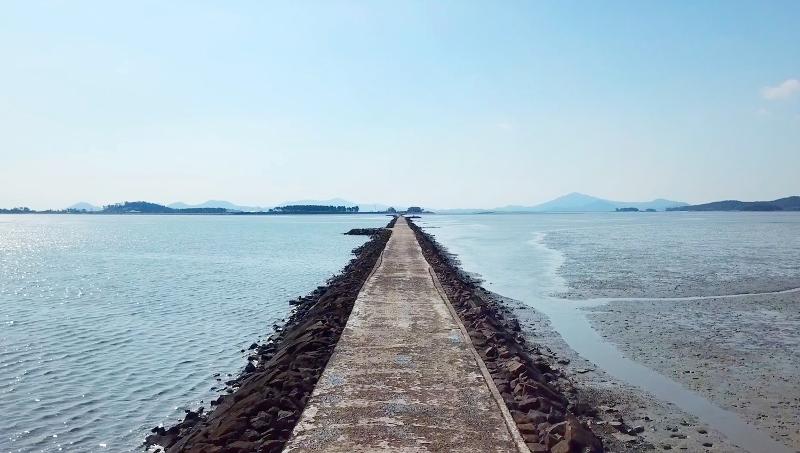
This is Hwado Nodugil, or a road made by piling large rocks, in Sinan-gun County. Mudskippers are seen here at low tide.
The sea route between the islands contains a story about the mudflat. Nodugil, or a road connecting the islands, appears twice a day when the tide ebbs. Residents built the road over time by piling large rocks at low tide, as movement between islands was difficult. Jungnodugil, or a road connecting Banwoldo and Bakjido islands, maintains its old form and appears only at low tide. Hwado Nodugil, however, which connects Jeungdo and Hwado islands, underwent construction about two years ago so that cars and people can pass whenever they please, even at high tide.
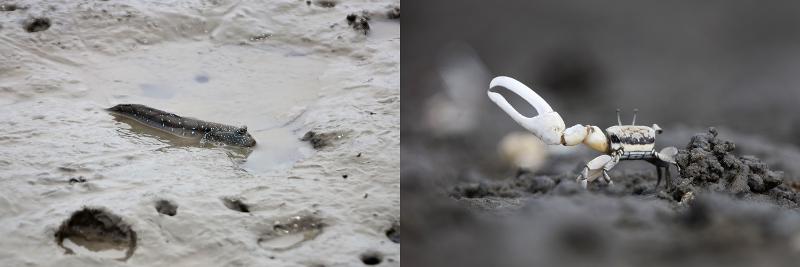
Mudskippers (left) and milky fiddler crabs are often see in the mudflat when the tide ebbs. The male milky fiddler crab has one claw larger than the other. (Sinan-gun County)
Tidal flats are an integral part of Sinan-gun in southwestern Korea. The flat in the county is about 378 square km, or about half the size of Seoul, as the nation's largest wetland preservation area. Last year, the Sinan Getbol (tidal flat) was designated World Natural Heritage by UNESCO.
Few facilities here cause pollution as the residents mostly engage in agriculture and fishing, so the area stays clean. Thus a major reason to visit Sinan-gun is enjoyment of nature.
■ Tidal flat and bay salt
Tidal flats provide a healthy gift -- bay salt -- that is confined to tidal waters and produced at salt farms. Among the county's estimated 800 salt farms, Bigeumdo and Shineuido islands have the most. In Bigeumdo, home to about 140 salt farms, Korea.net staff rented electric bicycles at the township office, and as they pedaled forward and looked sideways, they saw vast salt farms stretching ahead. They stopped in between to take photos of the sky reflected on the salt farm, and an hour just flew by.
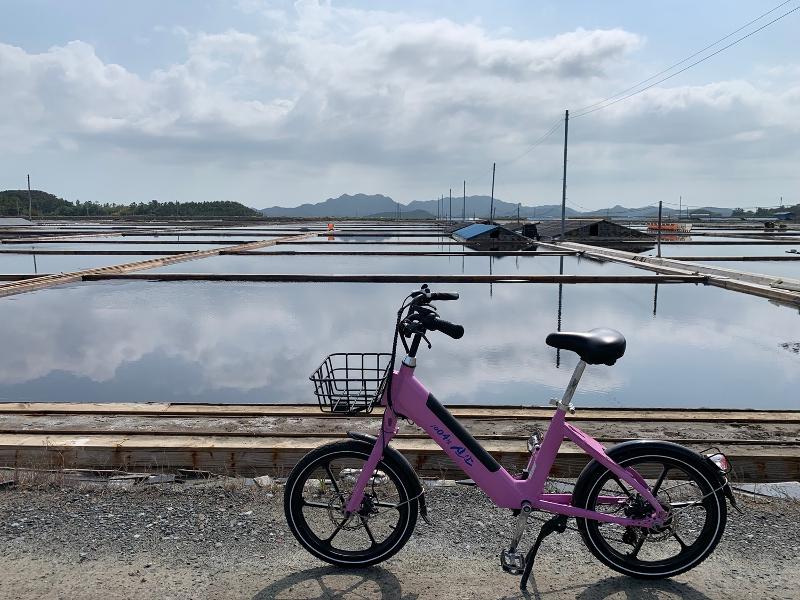
View of Bigeumdo Island. (Jung Joo-ri)
Looking around the salt farms, staff grew curious over how bay salt is produced. They reached Mahatap Salt Farm on Imjado Island around 4 p.m., when salt harvest was in full swing at the perfect time to directly see soft crystallized salt rising to the surface due to the scorching sun.
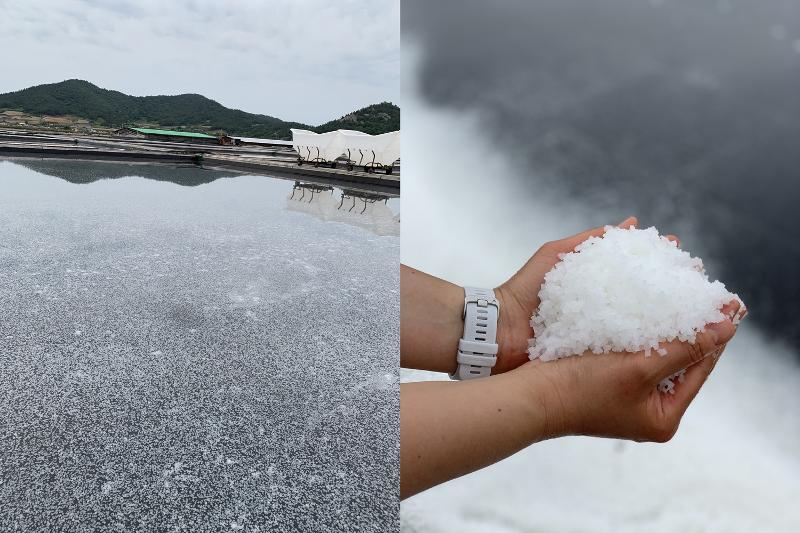
Bay salt freshly harvested from a salt farm (Jung Joo-ri)
A handful of bay salt showed that each salt particle was thick and hard. A taste on the tongue spread the salty taste throughout the mouth with no bitterness but a sweet aftertaste. This was different from the taste of refined salt, which is usually produced after two hours of electrolysis of seawater.
Yoo Eok-geun, head of Mahatap Salt Farm that who produces bay salt in Imjado, said the salt is "the taste given by the sea and tidal flat."
"If you collect seawater with a 3% concentration of salt at the first evaporating site, its concentration turns to 5%-6%. Move the salt to the second evaporation site, where the concentration rises to 11%," he said. "After the bay salt of 3mm or thicker is produced at the crystallization site, collect them in a warehouse and remove the water."
Forming a thick bay salt takes about 15 days.
The bay salt in Sinan-gun has a high concentration of minerals and magnesium thanks to the healthy tidal flat. "Sinan-gun's tidal flats have high quality and are abundant in minerals," Yoo added. "Hamcho are aquatic plants that absorb seawater and undergo photosynthesis. As they grow around the first evaporation site, they assume the role of purifying the seawater."
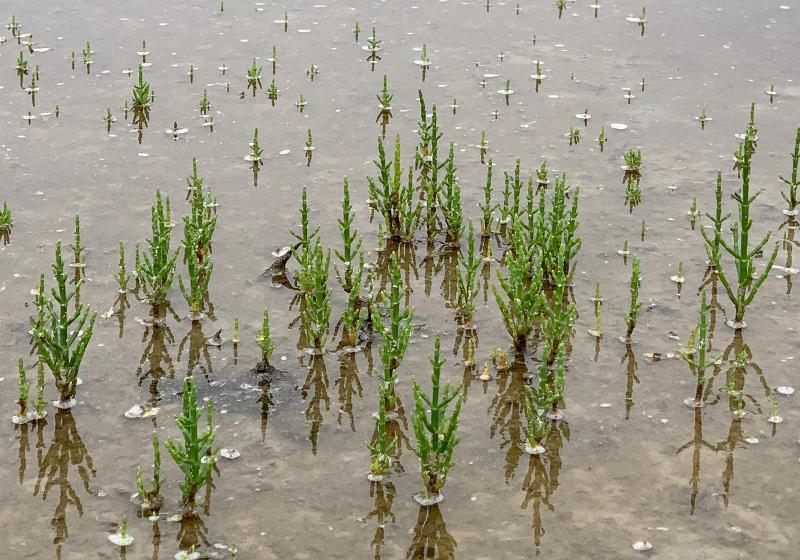
Hamcho (aquatic plants) are easily found at salt farms in Sinan-gun County. They are about the size of a palm and sturdy with a texture similar to sedum if you bite it. (Jung Joo-ri)
Tidal flats in the county offer so much to listen to and enjoy. From afar, they appear as gray land but inside are countless animals, plants and microorganisms. Humans receive from those places salt containing the taste of nature. This is the home of all living things coexisting in harmony. So consider spending this summer at the tidal flats of Sinan-gun County and listening to their stories.
Matatap Salt Farm, which produces bay salt on Imjado Island, runs the program World-Wide Opportunities on Organic Farms, or WWOOF, in which visitors help make salt for four to six hours in return for housing and food. Both locals and foreigners can apply. The program is not offered on rainy days, so please avoid such weather if you go. More information is available on the website http://wwoofkorea.org in Korean and English.
etoilejr@korea.kr
![[Hidden charms of Korea: Sinan-gun County] ① 'Angel' islands connect people to the se...](/upload/content/image/38e7654d4b9b4c069d11a02491d842c6_20220715113047.jpg)
![[Hidden charms of Korea: Namhae] ③ Exploring 'treasure island'](/upload/content/image/74d2c17bb0b14fba836dd57fb7a2acfe_20220426171319.jpg)
![[Hidden charms of Korea: Namhae] ② Stories of a tourist hotspot](/upload/content/image/c324412691c944c9ba33d6f535b813d1_20220426155551.jpg)
![[Hidden charms of Korea: Namhae] ① Trip for thinking about nothing](/upload/content/image/593df28b85e54b1e8dd6c086d9fa6b3e_20220427151613.jpg)